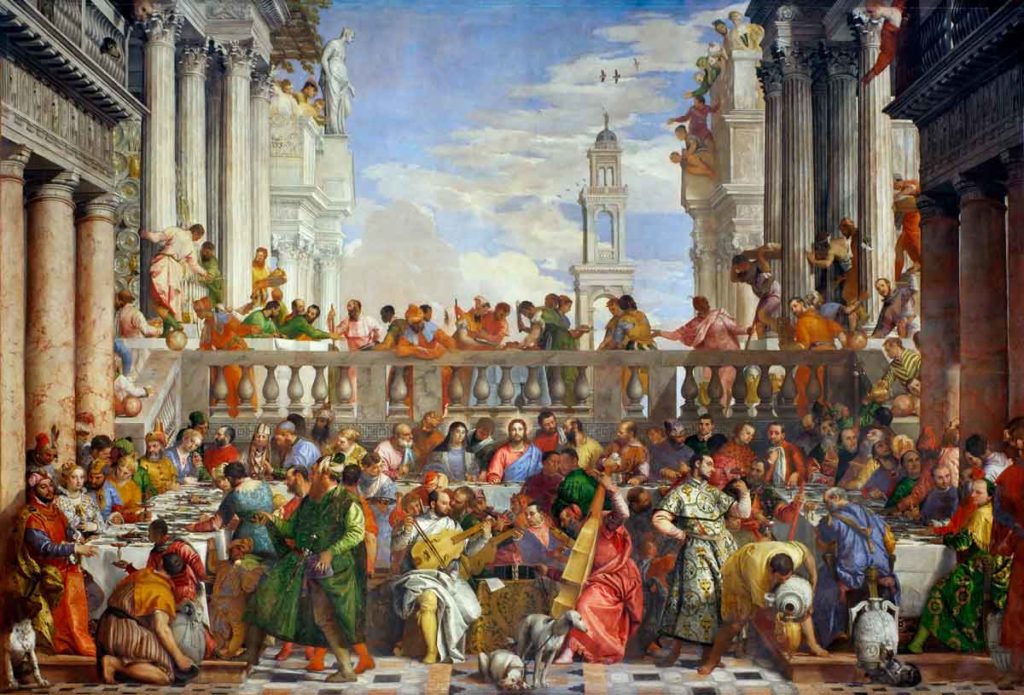What A Long, Strange Trip It’s Been
The celebrated depiction of a miracle is, by its very survival, a miracle in itself

Plunder: Napoleon’s Theft of Veronese’s Feast by Cynthia Saltzman; Farrar, Straus & Giroux, 336 pp., $30
One of these days the Louvre will reopen its doors and visitors will be able to see one of the world’s great paintings, The Wedding Feast at Cana (1562) by Paolo Veronese. No film or photograph can possibly do justice to this work, painted 459 years ago. It is a stupefying 32 feet wide by 22 feet high. When one considers that the painting was produced by artists working in the mid-16th century, its achievement, in those far-off days, must have seemed even more incredible than it does today.
Veronese was born in Verona but moved to Venice in his 20s, and established his mastery of scale early in his career by tackling the mind-boggling art of painting on a ceiling. By the time he had graduated to canvas, and scaffolding, the challenge of working at this scale must have seemed almost easy. Commissioned by the Benedictine monastery of San Giorgio Maggiore, the painting depicts the moment at a wedding feast when Jesus Christ, learning his hosts have run out of wine, turns water into wine, one of his first miracles.
But in Veronese’s rendering, the religious significance of the moment is obscured by the trappings of a boisterous party. Jesus himself is hard to find in the melee, and the bride and groom are inconspicuous at the far end of the table. Because this is a celebration, guests dressed in the latest styles dominate the foreground. One sees, as Peter and Linda Murray write in their 1959 book, A Dictionary of Art and Artists, “splendid, golden-haired women dressed in the height of fashion with horses, dogs, apes, courtiers, musicians, soldiers” robed in a passing parade of sumptuous silks, satins, brocades, and all manner of costly paraphernalia, posed against magnificent buildings and an azure sky.
The artist has depicted his subjects with such meticulous attention that the Inquisition started asking questions. How could Veronese possibly have included such profanities as dogs, drunkards, dwarfs, and suchlike? He painted what he saw, Veronese replied with time-honored logic. Luckily, his inquisitors did not press the point.
As Cynthia Saltzman explains in her new book, Plunder, the Veronese is but one of many 17th-century masterpieces the survival of which is a wonder in itself. In her previous books, she has taken other great works, for instance, Van Gogh’s Portrait of Dr. Gachet (1890), and put them into historical context. In 2008, she examined the process by which the Dutch-born art dealer Joseph Duveen, part salesman and part rascal, made use of the knowledge that “Europe had lots of art and America had lots of money”—a subject I also undertook to explain in my 2009 biography, Duveen: A Life in Art.
Saltzman has now tackled the peregrinations of this Veronese tour de force, which should, and would, have been left on its monastery walls were it not for the Napoleonic Wars and the particular psyche of the great man himself. There is grandeur buried somewhere in Napoleon’s instinctive choices—grandeur of a sort that defies easy analysis. Why would he, the consummate battlefield tactician and conqueror of Europe care not just for money and jewels—to which he was also susceptible—but also for the intangible and indefinable aura of mystery that this great work of art conveys? Whatever it was that attracted him, Napoleon went to enormous lengths to acquire and move the painting, along with all of the other works he procured, to his new Louvre Museum. It took six months and a perilous sea voyage to transfer the Veronese to Paris. Further months went into repairing the costly depredations of wind and salt water.
Part of this book’s fascination has to do with Saltzman’s authoritative retelling of how the work was rescued by concerned conservators time and again, from flaking paint, crumbling canvas, and rotting supports. Sometimes they saved it from outright disaster. In 1797, for example, the Veronese was deemed to be so impossibly unwieldy that it was actually cut in half. How it was artfully put back together is a riveting story.
Saltzman is particularly effective in describing the herculean efforts that the Louvre took to keep its treasures from falling into Nazi hands. Along with the other masterpieces, the Veronese was somehow whisked away (maybe in the dead of night?) and hidden in the vast cellars of the Chateau de Chambord in the Loire Valley. But then the German armies threatened to arrive, so off it went again, moved at least three more times when danger threatened. In 1946, the painting, one of the great museum’s most precious treasures, was hung once more in a prominent position, where it has remained ever since.
Saltzman writes: “Despite the triumph of abstract art, Veronese’s ability to conjure flesh-and-blood figures moving about in space, and the texture of embroidered silk and the light playing over it, with no more than brushstrokes of paint seemed no less miraculous. To the modern question, ‘What is Art?’ …. the Veronese still delivered a decisive answer.”
By recounting the long, strange journey of this painting through unsuspected wars, bloodshed, perilous seas, and finally, its close escape from Nazi hands, Saltzman makes one appreciate the beauty of The Wedding Feast at Cana anew. That it still exists is a miracle all by itself.
I hope she will keep on looking for new miracles.

